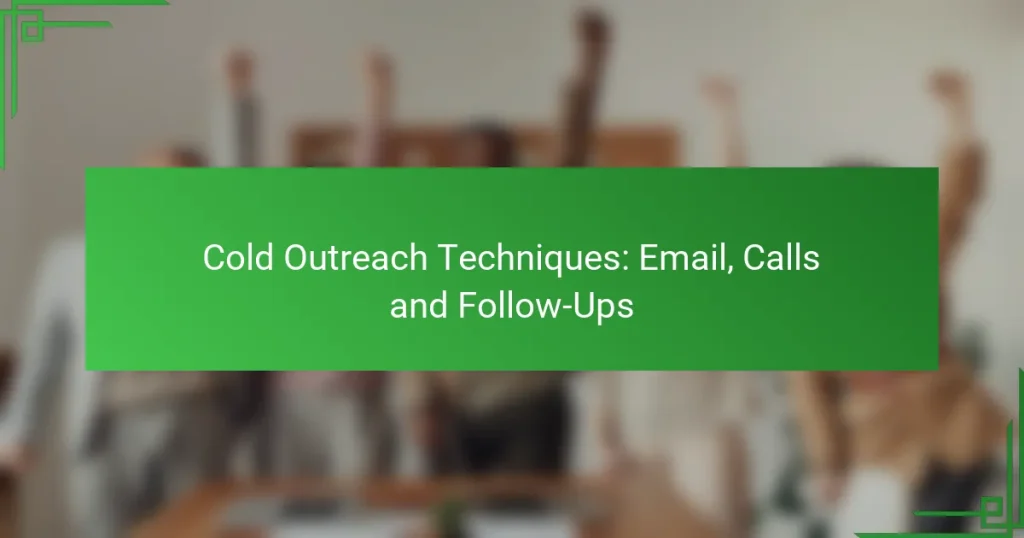Cold outreach techniques, including emails, calls, and follow-ups, are essential for engaging potential clients and driving business growth. By focusing on personalization, effective communication, and timely follow-ups, you can enhance your outreach efforts and build meaningful connections. Implementing these strategies will not only improve your response rates but also foster long-lasting relationships with your prospects.

What Are Effective Cold Outreach Email Techniques?
Effective cold outreach email techniques focus on capturing attention, building rapport, and prompting action. By employing strategies such as personalization, optimizing subject lines, and establishing a clear call-to-action, you can significantly improve your outreach success rate.
Personalization Strategies
Personalization is crucial in cold outreach emails as it helps establish a connection with the recipient. Use the recipient’s name, mention their company, and reference specific details that relate to their interests or challenges. This tailored approach can increase engagement and response rates.
Consider segmenting your audience based on industry or needs to create more relevant messages. For instance, if reaching out to tech startups, highlight how your product can solve common pain points in that sector.
Subject Line Optimization
Crafting an effective subject line is essential for ensuring your email gets opened. Aim for clarity and brevity, ideally keeping it under 50 characters. Use actionable language and pose questions that pique curiosity, such as “Are you struggling with [specific issue]?”
A/B testing different subject lines can help identify what resonates best with your audience. Avoid using all caps or excessive punctuation, as these can trigger spam filters and reduce open rates.
Call-to-Action Best Practices
A strong call-to-action (CTA) guides the recipient on what to do next. Make your CTA clear and specific, such as “Schedule a 15-minute call” or “Download our free guide.” Position the CTA prominently within the email to ensure it stands out.
Limit the number of CTAs to avoid overwhelming the reader. One or two focused actions are more effective than multiple options, which can lead to decision fatigue.
Timing and Frequency
Timing plays a significant role in the effectiveness of cold outreach emails. Research suggests that sending emails on Tuesdays or Thursdays during mid-morning or early afternoon can yield higher open rates. Avoid weekends and holidays when recipients are less likely to check their inboxes.
Frequency is also important; consider sending a series of emails spaced a few days apart. This keeps your message fresh in the recipient’s mind without being overly aggressive.
Follow-Up Cadence
Follow-ups are critical in cold outreach, as many recipients may not respond to the initial email. A good rule of thumb is to follow up two to three times, spaced about 3-5 days apart. Each follow-up should provide additional value or insights to encourage a response.
Be polite and concise in your follow-ups. A simple reminder of your previous email, coupled with a new piece of information or a different angle, can reignite interest without coming across as pushy.

How to Execute Cold Calls Successfully?
Successful cold calls require a combination of preparation, effective communication, and strategic closing techniques. By understanding your prospect and addressing their needs, you can significantly increase your chances of a positive outcome.
Preparation and Research
Before making a cold call, invest time in researching your prospect. Understand their business, industry, and pain points to tailor your approach effectively. Utilize platforms like LinkedIn or company websites to gather relevant information.
Develop a call script that outlines key points you want to cover, but remain flexible to adapt based on the conversation. Familiarize yourself with common industry terminology to establish credibility.
Opening Statements
Your opening statement sets the tone for the call. Start with a friendly greeting and introduce yourself and your company clearly. Mention a specific reason for your call that relates to the prospect’s needs.
For example, you might say, “Hi, I’m [Your Name] from [Your Company]. I noticed that your company is expanding into new markets, and I believe we can help streamline that process.” This approach grabs attention and shows relevance.
Handling Objections
Objections are a natural part of cold calling. Listen actively to the prospect’s concerns and acknowledge them without being defensive. This builds rapport and shows that you value their perspective.
Use techniques like the “feel-felt-found” method, where you empathize with their feelings, share a similar experience from another client, and explain how your solution helped them. This can turn objections into opportunities for further discussion.
Closing Techniques
Closing a call effectively involves summarizing the conversation and proposing a clear next step. Ask open-ended questions to gauge interest, such as, “How does this solution align with your current goals?”
Be direct in your closing, whether it’s scheduling a follow-up meeting or sending additional information. For instance, you could say, “Can we set up a time next week to discuss this further?” This encourages commitment and keeps the momentum going.

What Are Best Practices for Follow-Ups?
Best practices for follow-ups involve timely communication, relevant content, and utilizing multiple channels to increase engagement. Effective follow-ups can significantly enhance response rates and foster stronger relationships with potential clients or leads.
Follow-Up Timing
Timing is crucial for successful follow-ups. Generally, aim to follow up within 24 to 48 hours after your initial outreach to keep the conversation fresh in the recipient’s mind. If there’s no response, consider waiting about a week before sending a second follow-up.
Be mindful of the time of day as well; sending emails in the morning or early afternoon often yields better results than late in the day. Additionally, avoid weekends and holidays when your message may get lost in a crowded inbox.
Content of Follow-Ups
The content of your follow-ups should be concise and relevant. Start by referencing your previous communication to provide context, then clearly state your purpose for reaching out again. Personalizing your message can significantly increase engagement, so include any specific details that relate to the recipient’s interests or needs.
Avoid overly formal language; instead, aim for a friendly yet professional tone. Include a clear call-to-action, such as scheduling a call or requesting feedback, to guide the recipient on the next steps.
Multi-Channel Follow-Up Strategies
Using multiple channels for follow-ups can enhance your chances of getting a response. Consider combining email with phone calls or social media messages to reach your audience where they are most active. For instance, if you’ve sent an email and haven’t received a reply, a brief follow-up call can be effective.
When using different channels, ensure your messaging remains consistent. Tailor your approach based on the platform; for example, a more casual tone may work better on social media compared to email. Tracking your outreach across channels can help you identify which methods yield the best results.

What Criteria Should You Use to Evaluate Cold Outreach Tools?
When evaluating cold outreach tools, consider factors such as integration capabilities, user reviews, and cost-effectiveness. These criteria will help you choose a tool that fits your outreach strategy and budget while ensuring smooth operations.
Integration Capabilities
Integration capabilities refer to how well a cold outreach tool connects with other software you use, such as CRM systems, email platforms, and marketing automation tools. A tool that integrates seamlessly can streamline your workflow, saving time and reducing errors.
Look for tools that offer APIs or pre-built integrations with popular platforms like Salesforce, HubSpot, or Mailchimp. This will enhance your data management and improve the overall efficiency of your outreach efforts.
User Reviews and Ratings
User reviews and ratings provide insights into the real-world performance of cold outreach tools. Checking platforms like G2 or Capterra can help you gauge user satisfaction and identify common issues.
Pay attention to both the quantity and quality of reviews. A tool with a high number of positive reviews is generally more reliable, while consistent complaints about specific features may indicate potential drawbacks.
Cost-Effectiveness
Cost-effectiveness evaluates whether the benefits of a cold outreach tool justify its price. Consider not only the subscription costs but also any additional fees for features or integrations.
Compare tools within your budget range, typically from low tens to several hundred USD per month, depending on the features offered. Look for free trials or tiered pricing to find the best value for your specific outreach needs.


